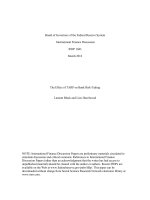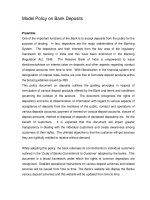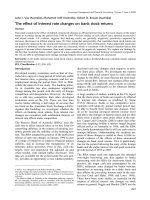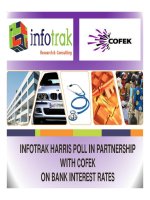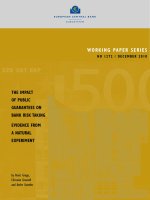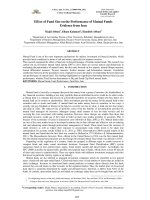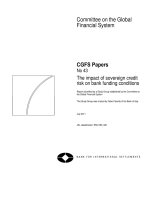Comment on bank performance
Bạn đang xem bản rút gọn của tài liệu. Xem và tải ngay bản đầy đủ của tài liệu tại đây (60.93 KB, 6 trang )
Return on Equity is a measurement of how effectively a business uses equity or the
money contributed by its stockholders and cumulative retained profits to produce
income. As can be seen in the comparison table, the ROE of 2019 is 2.08% higher
than that of 2018. The rising in ROE of Sacombank tells us that the bank’s profit
generation was increasing without as much capital needed. It also indicates how
well Sacombank’s management deploys shareholder capital.
An increase in ROE results from an increase in the value of Equity Multiplier. That
ratio of Sacombank increased slightly, at 16.96X. It was not too low or too high
multipliers since according to Bank Management and Financial Services (The
McGraw – Hill_Irwin Series in Finance, Insurance, and Real Estate 2010), this
ratio is normally the largest, averaging 10X or more for most banks. Bigger banks
sometimes operate with multipliers of 20X or more. The higher a company’s equity
multiplier, the higher it's debt ratio because it indicates that a significant portion of
a firm’s assets is financed by debt. The larger the multiplier, the more exposed to
failure risk the financial institution is. However, the larger the multiplier, the
greater the potential for high returns for the stockholders. A low multiplier
indicates that neither the firm is unable to obtain debt from lenders nor the
management is avoiding the use of debt to purchase assets.
From the Consolidated financial statement of Sacombank 2019, Earning per share
was increased from VND 780 million to VND 1,119 million. P/E Ratio and EPS
are a negative relationship so as the rise in EPS, the P/E ratio decreases by 4.66%
compared to 2018 (12.04%). Decreasing the P/E ratio and rising in EPS in lead to
the decrease of share price, from VND 9,391.2 to VND 8,228.22. (chỗ này t k chắc
về đơn vị)
The Return on Assets shows how well a company utilizes its assets, by determining
how profitable a company is relative to its total assets. In comparison table, ROA
in 2019 increased slightly from 0.11% to 2018 (0.46%). The higher ROA, the
better management.
Net Interest Margin (or NIM) is the most important indicator for all banks because
it acts as the pulse that can show the health of the bank. NIM measures how large a
spread between interest revenues and interest costs management has been able to
achieve by close control over earning assets and pursuit of the cheapest sources of
funding. If NIM is negative, it means that the bank is not making the right business
decisions. Simply, the bank has lost money on expenses more than what it has
earned from its investments. With NIM of Sacombank, it was positive in both 2018
and 2019. It rose slightly from 2.33% in 2018 to 2.44% in 2019. The figure told us
that Sacombank was using its assets effectively and credit growth is over accretive
than deposit growth. The higher margin, the higher profit for the bank will be.
In contrast with NIM, Net Noninterest Margin measures the amount of non –
interest revenues stemming from services fees the financial firm has been able to
collect relative to the number of noninterest costs incurred. The increasing in Net
Noninterest Margin of Sacombank shows that …………. (need help)
Net Operating Margin indicates how well management and staff have been able to
keep the growth of revenues ahead of rising costs. Evidence for the effectiveness of
management is showed by the climbing of Net Operating Margin from 6.73% to
6.90%.
The earnings spread measures the effectiveness of a financial firm’s intermediation
function in borrowing and lending money and also the intensity of competition in
the firm’s market area. Earning spread increased from 2.69% (2018) to 2.77%
(2019).
Net Profit Margin is one of the most important indicators of a company’s financial
health, which helps investors evaluate if the management of a business generates
enough profit from its sales and whether operating costs and overhead costs are
being contained. As can be seen in the comparison table, Net Profit Margin rose
1.01%, from 5.95% (2018) to 6.96% (2019). It means that Sacombank performed
better than the previous year.
Asset Utilization is important to a company because its success is often related to
its capacity to manage and leverage its assets. With 7.78% asset utilization of
Sacombank, they still do good in controlling its assets.
Tax Management Efficiency of Sacombank soared nearly 4 times from the
previous year (from 1.78% to 6.29%). It means that Sacombank lost 6.29% of their
income after tax to taxation. The tax-management efficiency ratio reflects the use
of security gains or losses and other tax-management tools (such as buying taxexempt bonds) to minimize tax exposure. In contrast with Tax Management
Efficiency, Expense Control Efficiency reduced from 8.61% to 2.66%. That
number indicates that Sacombank performed well in controlling expenses.
Asset Management Efficiency, Funds Management Efficiency and Operating
Efficiency ratio increased slightly. A rise in the value of the Operating Efficiency
ratio of Sacombank indicates an expense control problem because the total
operating expense of this bank increased more than 1X to that of 2018.
In 2019, Sacombank’s total net income reached 2,454 billion dong positively,
increased up to approximately 27.08% over 2018, which showed a good sign of
Sacombank’s profitability. On which, the net interest income achieved more than 9
billion dong, rised by 16.85% compared with its data in the previous year.
According to the statistics above, Sacombank’s total assets gained nearly 453,600
billion dong, decreased slightly from 2018 to 2019 (406 billion to 453 billion
respectively). Its total liabilities and total equity captial illustrated a small change
between 2 years.
Total interest income rised 7.89% to reach closely VND 30.5 billion in 2019, while
as one of the top 10 Vietnamese banks with the largest non-interest income
recently, Sacombank’s non-interest income was worth VND 6.3 million (25.19%
higher than 2018). In addition, the fee and commission income in 2019 was
increasing 21.5% over the past year.
Among with interest and noninterest income, the bank’s total interest expense rised
up to 12.4% at 21.3 billion dong, and its total non-interest expense performed a
small number of 1.5 billion dong.
In the business operation, the figure for total operating revenue and total operating
expense increased concurrently to reach VND 35,28 billion and 9,26 billion
respectively, resulting in the growth of 20.2% in total operating income to reach
VND 14,63 billion. This number may satisfy the bank’s investors, owners and its
shareholders because the higher the operating income, the more profitable a bank’s
core business achieve. In addition, the earning asset also went up to 12.3% from
2018 to 2019 and gained 3.77 trillion dong in total throughout 2019.
In contrast, Sacombank’s total interest bearing liabilities rised from 3.54 trillion to
more than 4 trillion dong, which means that the corporation must pay more interest
of debts to finance even if it plans to pay off the account in a very short-term (less
than a month).
Moreover, while 2018 recorded the net gain from investment securities of
positively 18 thousand dong (P/s: chỗ này số liệu là 18004 t không hiểu lắm là 18
nghìn à), 2019 stated a huge decrease in the number to 50 thousand dong
negatively (or in other words, between the two years, investment securities
changed badly from net gain to net loss).
A special highlight of the bank’s performance is its profit before tax, which was
exceeded the plan committed at the Shareholders’ General Meeting by 21.4%
profitability gradually improved. The statistics showed that profit before tax in
2019 drastically up to 43.2% to reach 3,217 billion dong.
P/s: Phanh với Lan ơi trong báo cáo thường niên ghi profit before tax năm 2019
của Sacombank là 3,217 tỉ đồng với t search google website sacombank + trên
mấy báo cũng thế. Mà trong bảng của mình t lại thấy ghi là 440551 (?) nên thử
check lại xem nhé
Link báo cáo thường niên (ở trang 24):
/>STB_AR2019_Eng.pdf
Finally, although provision for loan loss can lower operating profits, the
corporation accepted to increase its ratio from -1.97% to -1.62% to prevent risks
better.
In short, inspite of some unwanted decrease in some statistics, Sacombank still
affirm that they did really well in 2019, they have the ability and high potential to
develop significantly in the future and hold their position as one of the Top bankes
in Vietnam stably.
REFERENCES:
Inc. staff, (2020, Feb 6). Return on Assets. Retrieved from
/>Interpreting operating profit margins versus net profit margins. Retrieved from
/>What
is
Equity
Multipliers?.
Retrieved
from
/>%20cost%20of%20capital

